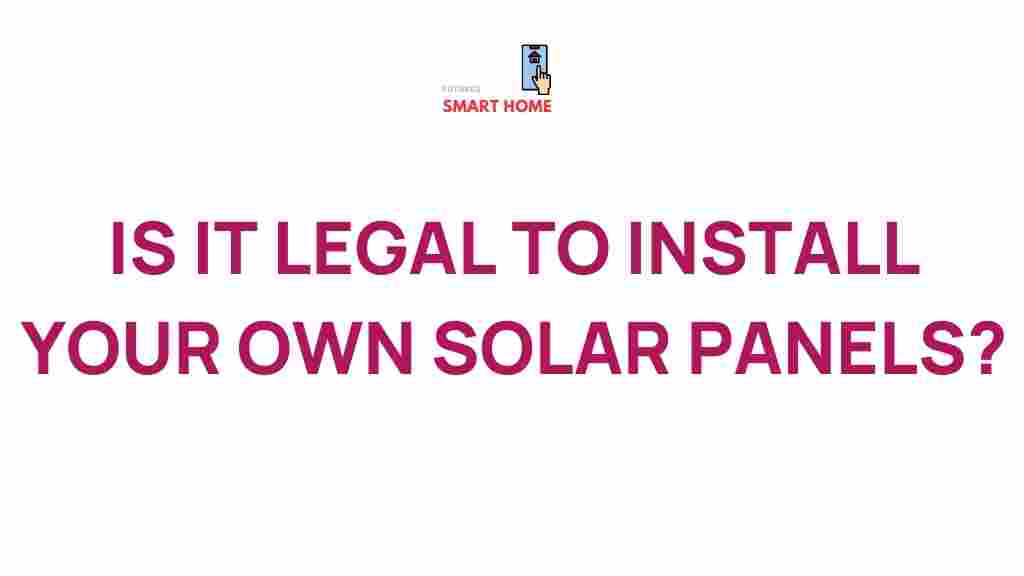Unveiling the Legalities of DIY Solar Panel Installation
As the world shifts towards renewable energy sources, many homeowners are considering DIY solar panel installation as a viable option. The allure of harnessing the sun’s energy to power your home is not just about saving money; it’s also about contributing to a cleaner environment. However, before you embark on this exciting journey, it’s crucial to understand the legal and regulatory landscape surrounding DIY solar panel projects. This article will guide you through the essential guidelines that every homeowner should be aware of when considering solar panel installation.
Understanding the Legal Framework for DIY Solar Panels
When it comes to installing solar panels on your property, various regulations and laws come into play. These can vary significantly based on your location, so it’s essential to do your homework. Here are some key legal considerations:
- Zoning Laws: Check local zoning regulations to ensure that your solar panel installation complies with property use and development standards.
- Building Codes: Adhere to any local building codes that dictate how structures, including solar panel installations, must be constructed.
- Permits: Many jurisdictions require permits for solar installations. This could range from electrical permits to structural permits.
- Homeowners Association (HOA) Rules: If you live in a community governed by an HOA, review their rules regarding solar panel installations, as they may have specific guidelines or restrictions.
Step-by-Step Process for DIY Solar Panel Installation
Once you have a clear understanding of the legal requirements, you can begin the installation process. Here’s a comprehensive step-by-step guide:
1. Assess Your Energy Needs
Before purchasing solar panels, evaluate your energy consumption. Look at your electricity bills from the past year to determine how much energy you use monthly. This assessment will help you choose the right solar panel system size.
2. Research and Select Solar Panels
There are various types of solar panels available, including monocrystalline, polycrystalline, and thin-film. Research the pros and cons of each type to determine which best fits your needs and budget.
3. Check Local Regulations
As mentioned, ensure that you are compliant with local regulations, including zoning laws and necessary permits. This step is crucial to avoid legal issues later.
4. Design Your Solar Panel System
Create a design for your solar panel setup. Consider factors like panel placement, angle, and orientation to maximize sunlight exposure. You can use online tools or consult with professionals for assistance.
5. Purchase Equipment
Acquire all necessary equipment for your solar panel installation, including:
- Solar panels
- Inverters
- Mounting hardware
- Wiring
- Battery storage (optional)
6. Install the Solar Panels
Follow the manufacturer’s instructions carefully during installation. Here are some critical aspects to consider:
- Mounting: Ensure that the solar panels are securely mounted to withstand wind and weather conditions.
- Wiring: Properly wire the solar panels to the inverter and the electrical system of your home. If you’re not comfortable with electrical work, consider hiring a professional.
- Safety: Always prioritize safety. Wear appropriate gear and consider working with a partner when installing panels on your roof.
7. Connect to the Grid (if applicable)
If you plan to connect your solar panel system to the grid, follow the necessary procedures to notify your utility company. Some regions require interconnection agreements and additional inspections.
Troubleshooting Common DIY Solar Panel Installation Issues
Even with careful planning, issues can arise during and after installation. Here are some common problems and troubleshooting tips:
1. Low Energy Production
If your system is producing less energy than expected, consider the following:
- Check for shading from trees or buildings.
- Ensure the inverter is functioning correctly.
- Inspect wiring connections for any loose or damaged wires.
2. Electrical Issues
If you experience electrical problems, such as tripped breakers or flickering lights:
- Turn off the system immediately and check all connections.
- Consult the inverter manual for troubleshooting tips.
- If issues persist, contact a licensed electrician.
3. Structural Concerns
If you notice any structural issues with your roof post-installation:
- Evaluate whether the mounting system is secure.
- Consider hiring a structural engineer to assess the roof’s integrity.
Conclusion: Embracing Renewable Energy with Confidence
Installing DIY solar panels can be a rewarding experience, both financially and environmentally. However, it is essential to navigate the legal landscape carefully. By understanding the regulations and guidelines, conducting thorough research, and following a structured installation process, homeowners can successfully harness the power of the sun.
For more detailed information on renewable energy and legal requirements, you can visit this resource. Remember, while DIY projects can save you money, don’t hesitate to consult professionals when in doubt, particularly regarding electrical work and local regulations. Embrace the power of renewable energy confidently and contribute to a sustainable future!
This article is in the category Guides & Tutorials and created by FutureSmarthome Team

1 thought on “Unveiling the Legalities of DIY Solar Panel Installation”